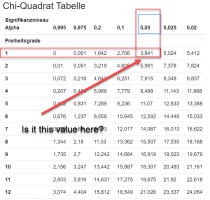Apppreciate_your_help
New member
- Joined
- May 2, 2022
- Messages
- 13
Hi all
As a beginner I have a question, where I'm looking for a solution with an explanation:
In 100 tosses of a coin, heads were observed 15 times and tails 85 times. At the 0.05 significance level, test the hypothesis that the coin is fair. Use the chi-square goodness of fit test.
Many thanks for your help. Best regards
As a beginner I have a question, where I'm looking for a solution with an explanation:
In 100 tosses of a coin, heads were observed 15 times and tails 85 times. At the 0.05 significance level, test the hypothesis that the coin is fair. Use the chi-square goodness of fit test.
Many thanks for your help. Best regards

